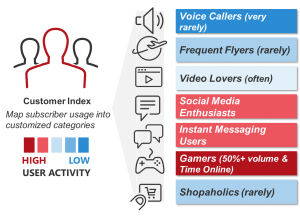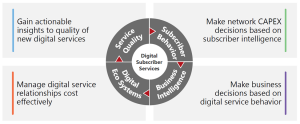Selling Services by the Slice
5 MAY 2020
How network slicing will reshape the business of telecom.
For the past five years (or so) communication service providers (CSPs) have been laser-focused on upgrading their networks to 5G. Now that this has become a reality for many of the larger operators, another question is quickly gaining center-stage: “How are we going to make money off of this?”
In years past, a major technology upgrade (i.e. – a new ‘G’) would be about enhanced speed or network coverage – but would still be limited to ‘best-effort’ connectivity to everyone across the board. This makes sense when what you’re selling is the same for everyone, but 5G changes things in a BIG way. Service providers can finally offer a whole array of differentiated services to their customers. With network slicing, the focus will begin to shift away from selling the network – to selling what the network enables. This may seem like a small difference, but it’s huge, and it’s the way CSPs will be able to start monetizing costly network investments.
A New Marketing Mindset
Today, most operators bill for services on a monthly basis, but 5G will allow them to sell additional services in new ways. One time offers and annual recurring models are good examples of this. For instance, if you, as a wireless subscriber, love NFL football and you have a VR headset, you may be interested in enhancing your game-day experience by watching the Super Bowl in a way that will make you feel like you’re a coach on the sidelines. If the operator knows you are a football fan, they will be able to promote their VR Super Bowl package. If all goes well, you are likely going to purchase this service again next season. Your subscriber profile might also indicate that you like eSports, or that you will likely purchase the Olympic VR package as well. Just like retailers, who strategically place impulse purchases at the check-out counter, service providers will be able offer impulse purchases as well – by directing them to the right audience at the right time.
Today’s traditional telco would miss these opportunities because their operating model is set up to operate networks, not innovate new services or understand their subscribers at this level. With 5G network slicing, this will need to change. But it’s about more than targeted advertisements and recommendations. CSPs will also need to sustain ‘memory’ of past actions for each customer in order to anticipate their needs more effectively. To do this, service providers will need to link what’s happening in their network and back office with what the customer is experiencing and how they are behaving. This information can help intelligently shape what services the provider will offer in the future, saving time, money and other valuable resources. Instead of launching ten new services and having seven fail, the operator will be able to use analytics to identify in advance which two or three will most likely succeed.
The Changing Customer Landscape
The customers of network slicing will not only be the ‘traditional’ telecom subscribers of today; they will also include wholesale customers (MVNEs, MVNOs), enterprises, industry players, innovators, and application providers. Partners, such as system integrators and commercial partners from other verticals will also be consumers of network slices, while providing industry expertise and working with the CSP in a more integrated way. There will also be internal customers of slicing as well. Those within the network operator – such as various product and development teams, or different units managing different parts of the network, that will be involved in shaping new service offerings. And when it comes to these new services, the list is almost endless. It will likely include hospitals delivering virtual care through telemedicine, or sports networks providing live stream coverage from the sidelines -or from a drone flying overhead. In fact, there may be drones delivering live video feeds to first responders, and prescriptions to people too sick to go to the pharmacy. In other words, cellular connectivity isn’t just about connecting smartphones anymore; it’s about creating tailored slices of service for a world of connected things.
One of the most critical things about these new slices is that they will be backed by business performance KPIs and SLAs designed to track the quality of the service. With these guarantees in place, ‘customized’ connectivity will be able to be sold at a premium. This should be great news for an industry that has worked within the thinnest of margins for far too long.
Around the world, CSPs are already beginning to explore these new monetization opportunities. Singtel, SK Telecom and AIS recently announced a regional joint venture to explore e-sports and gaming revenue streams. Since there are some 200+ million gamers in their markets, that’s probably a good bet. At TEOCO, we are currently working with several large operators to help define their 5G drone strategy and services- so they can be ready when regulators eventually ease restrictions. The list is almost endless, and it will be up to the operator to understand their market and develop services that make good financial sense.
Network slicing, also known as network customization, requires that operators develop, launch, continuously innovate, adapt, customize and evolve services in response to emerging market needs and capitalize on new devices and technology. Slicing offers operators and their partners the opportunity to stay ahead of competition – but it requires a new mindset. One that is focused on understanding the customer at the individual level – and then designing and marketing customized services based on these findings.
Figure 1 below highlights an example of TEOCO’s Customer Index, which shows how we map subscriber usage data to different service categories. In today’s world of micro-targeted offerings, an obsession with the customer will be needed for service providers to stay competitive; with an understanding of who they are and what they want, with the ability to measure their end-to-end connected experience.

(Figure 1- Customer Index)
Much like how retail shopping has been disrupted by Amazon, telecom is quickly evolving in the same way. There is great opportunity ahead for CSPs when it comes to 5G, but with customer expectations this high, they need to get it right.
Data Drives Customer Focused Opportunities
Success will be determined by how quickly operators can adapt and navigate in this new service and application-driven telecom marketplace, and one of the most critical factors for success will be making sure these efforts are not limited by underlying technology designed for simpler times. But where do they begin?
Analytics provides insights for creating, launching and supporting new digital subscriber services. While analytics can drive the insights, it’s the data that drives the analytics. Fortunately, CSPs are sitting on a gold mine of network, device, customer and business data. But for most, it’s true power can’t be realized because it is often spread across multiple systems, silos and databases.
Building A Data-Driven Telco

The ability to gain actionable intelligence is indispensable as a way for service providers to deliver on savings and monetization goals and improve network performance. They must view the subscriber from multiple facets; a 360-degree subscriber experience view that correlates and analyzes data from various departments within the service provider, including customer care, finance, marketing, network, service assurance and others. Handset data also provides a valuable source of analytics that is gathered and measured very close to the edge, delivering real-time insights into the subscriber experience.
The Right Partner
At TEOCO, big data and analytics is in our DNA. TEOCO SmartHub Analytics Platform mines value from mountains of data through predictive and prescriptive analytics, helping to maximize network and business performance by providing a 360-degree view of each subscriber within the operator. Today, we provide the value of big data analytics across four key areas: Business/Finance, Radio Access Networks (RAN), Service Assurance, and Device and IoT. When brought together, this information is pure gold – allowing service providers to make the pivot required to compete in a more customized 5G world.


